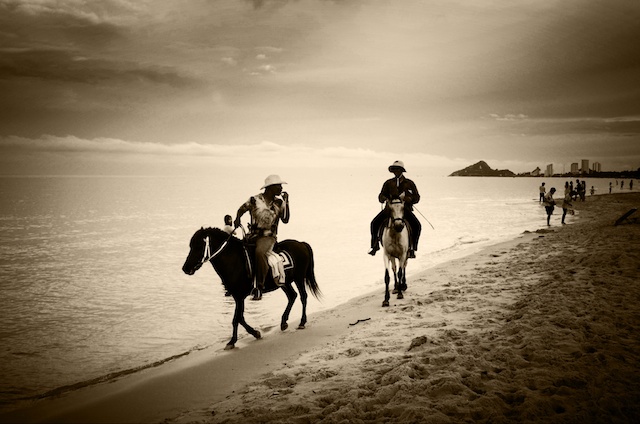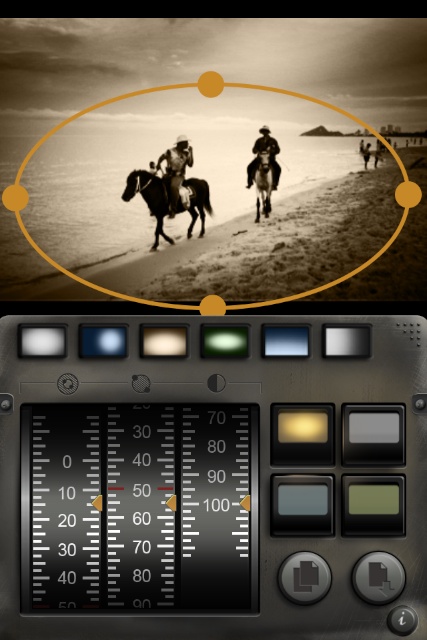Noir: Interesting Monochrome Effects App for iOS Devices, with some Minor Shortcomings

AMITIAE - Sunday 10 February 2013
|
Noir: Interesting Monochrome Effects App for iOS Devices, with some Minor Shortcomings |
 |
|
|
By Graham K. Rogers

IntroductionPublishing has changed. Not so long ago the only way to produce first-class output was to use a quality camera, film with the lowest ISO (or ASA) rating possible, expensive rotary scanners, top end computers and expensive paper.Digital technology changed that for publishing and home use alike. With easier work processes for home users, along with more powerful computers, consumer-level devices can produce quite respectable output. Many entry-level cameras do not have the sort of digital recording medium (CCD or charge-coupled device) of top level devices. However, the use of the internet and social networking sites mean that for many, the end display medium of these less expensive devices works fine. The main problem with many images, however, cannot be fixed by a camera or by any software. The difference is the user. I was taught in the mid-1980s on the streets of New York by Tony Harvey the director of The Lion in Winter (we met at a Thanksgiving party the night before) that the camera in your hand does not matter. With his SLR against my plastic cartridge film camera, he showed me how to use position and location to improve a shot.
Similar effects are available using digital techniques, like vignetting and brushes (e.g. dodge and burn). With the iPhone and iPad a number of apps also provide ways in which images may be adjusted or enhanced. Several apps use filters to apply effects although some provide more subtle ways in which changes to a photograph may be made. I updated an app on Sunday morning and had a look at the display of those that others had downloaded as well. One of these was the interesting Noir (the icon attracts) and when I looked closer was intrigued by the interesting screen shots for both iPhone and iPad. Not particularly expensive at $2.99 (although an SMS message from my credit card company thanked me for spending $1), this had soon joined my collection.
Noir As ever, I began with the iPhone where the three main sets of controls are available under the image panel. Tapping on the panel accesses the Photo Library. There is no camera access. I think this is preferable as I do not like to work directly in an app. I like to adjust after the original is taken and is safe.
As ever, I began with the iPhone where the three main sets of controls are available under the image panel. Tapping on the panel accesses the Photo Library. There is no camera access. I think this is preferable as I do not like to work directly in an app. I like to adjust after the original is taken and is safe.
Just below the image are 6 presets. These are different tones and shapes. When pressed the image changes colour and an adjustable control is displayed over the image to reduce or increase the area affected. Barely visible to the right of these presets is a dotted arrow that rotates the image 90 degrees and allows vignette adjustments to be made (almost) full screen. Below are three scroll wheels that provide ultra-fine adjustments for outer exposure, inner exposure and contrast. To the right of the wheels are four tone buttons: sepia, monochrome, cyan and a green tint. Pressing one of these affects the whole image and does not remove any adjustments already made. There is no "Back" button, so adjustments cannot be undone. Two buttons at the bottom (right) of the screen are for file commands. The first accesses the Photo Library for a new image. The second saves the current image, then allows the user to choose a new image from the Library. Just below is an "i" for Information that reveals a simple, but useful, text outline of the app. There was no link from the app to the developer site although the Red Giant Software site was easily accessed from the iTunes store.
Apart from it being easier to take photographs with the iPhone, the final output (see below) is no different on the two devices. By sharing images between the iPhone and iPad, it may be better for some to take photos on one and manipulate on the other.
Exporting and CommentsOn the iPhone, two image were exported to the Library and were shown as 2048 x 1358 (2.8MP) with a file size of 523 KB. I also checked with a photograph of 8 MP taken with the iPhone. The 3264 x 2448 image had a file size of 2.23 MB. When processed using Noir, the end result was an image of 2048 x 1536 (3.1 MP) with a size of 543 KB.Later, on the iPad, I used images imported directly into the Photo Library from my Nikon D7000 using the Apple Camera Connector Kit. These were imported to Aperture using PhotoStream and were 4928 x 3264 (16.1 MP) with a file size in the region of 17.85 MB (no wonder Aperture is getting slow). The iPad screenshots were 1536 x 2048 MP and a file size of 1.72 MB which made it rather disappointing to find that an image exported by Noir was only 552 KB with a size of 2048 x 1357, the same as on the iPhone. The information section of the app points out that images are always saved at the original resolution, however the refers to the optimised images used in an iOS Photo Library. As usual, I exported an image from Aperture as a full size (8-bit) TIFF image which I opened in Graphic Converter. The crisp image was shown as 28.44" x 18.85" but did not take much scaling up.
What Noir gives with one hand, it snatches away with the other.

Graham K. Rogers teaches at the Faculty of Engineering, Mahidol University in Thailand. He wrote in the Bangkok Post, Database supplement on IT subjects. For the last seven years of Database he wrote a column on Apple and Macs. |
|

For further information, e-mail to

|

|